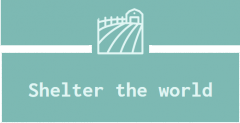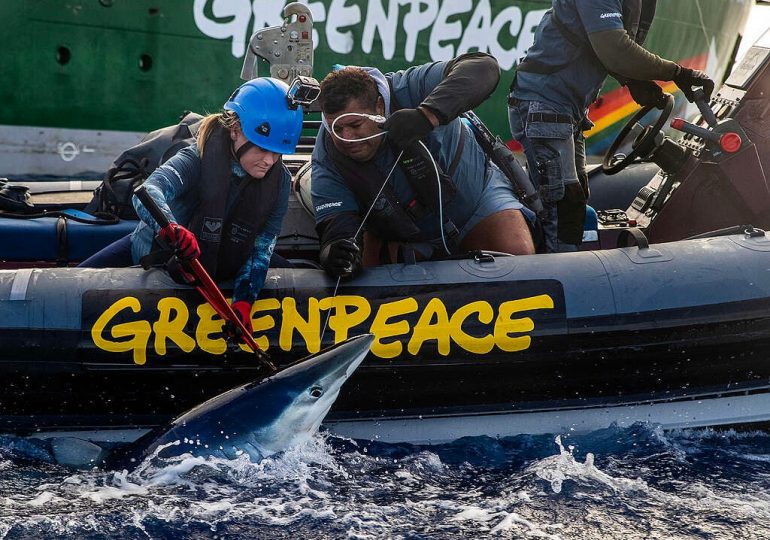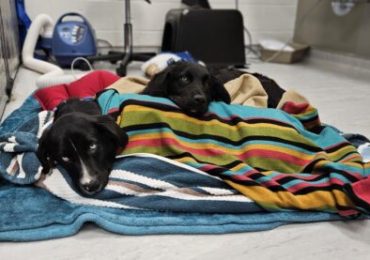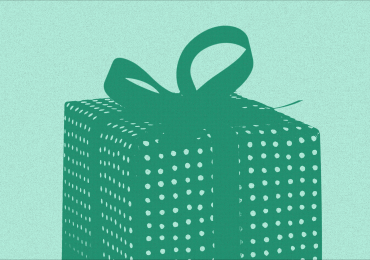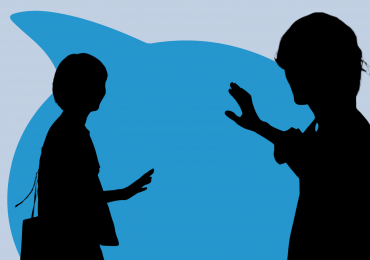This week, the crew aboard the Rainbow Warrior pulled off something incredible.
In the high seas around Australia and Aotearoa, Greenpeace Australia Pacific disrupted a massive industrial longlining operation. Over the course of several hours, our team confiscated almost 20 kilometres of deadly longline fishing gear out of the water and freed nine sharks, including an endangered longfin mako.
We’ve been out here documenting industrial longliners for weeks, but this vessel was next-level destructive.
Greenpeace activists free a blue shark caught on a longline. Photo: Paul Hilton / Greenpeace
What we found on the line
Longlining is an indiscriminate fishing method that can kill any animal in its path. As we hauled the line out of the water, we were confronted with animals tangled and fighting for their life.
The expert Greenpeace team, including an experienced shark handler, freed:
One endangered longfin mako shark
Eight near-threatened blue sharks
Four swordfish
One Ray
Our boat crew worked quickly to cut them free and safely release them, allowing the animals to swim away with a second chance at life. It was devastating to think of all the marine life on long line hooks across the world that we couldn’t save.
The line itself came from an EU-flagged industrial fishing vessel we’d been monitoring. The individual vessel we targeted caught over 600,000kg of shark in 2023, that’s an estimated 5527 sharks in one year alone. These ships claim to be targeting tuna and swordfish, but hook after hook, we saw sharks — some critically endangered — hauled up, dead or dying.
In fact, during just half an hour of observation, we documented three endangered Mako sharks being dragged out of the water and onto their boat to be killed.
Why this action mattered
Longlining is one of the most destructive fishing methods on the planet. Vessels deploy lines up to 100 km long with thousands of hooks that catch and kill indiscriminately, including sharks, turtles, seabirds and rays. It’s the industrialisation and destruction of the ocean.
New analysis from our team revealed that in 2023 alone, nearly 70% of the catch from EU longliners in parts of the Pacific was blue sharks — the most fished shark worldwide, now being wiped out in record numbers.
Our action this week didn’t just save the sharks we freed. It sent a message to the industrial fishing fleets plundering these waters: the world is watching.
What happens next
This all comes as world leaders head to the UN Ocean Conference in France next week to talk about the future of our oceans. The timing couldn’t be more important.
Greenpeace is demanding that governments, including Australia, ratify the Global Ocean Treaty and commit to the goal of protecting 30% of the ocean by 2030. It’s time for the Australian government to step up and propose world-first marine sanctuaries in places like the Tasman Sea, so operations like this can’t continue in secret.
The Treaty, once put into force, will allow the creation of vast protected areas where industrial longliners can’t reach and give the ocean a fighting chance.
The flagship Rainbow Warrior moves alongside the Spanish vessel, Playa Zahara, to bear witness to industrial fishing. Photo: Paul Hilton / Greenpeace
Greenpeace has been defending the oceans for 50 years — and we’re not stopping now
For more than half a century, Greenpeace ships like the Rainbow Warrior and now our very own Oceania have been on the frontlines of stopping industrial destruction and protecting our world. We’ve been boarded, bombed and impounded, but we’ve never backed down.
As the team now sails on to greet our colleagues in Aotearoa and commemorate the 40th anniversary of the bombing of the Rainbow Warrior, the fight for our planet is far from over. It’s never been more important for us to rise together, take collective action, and protect the ocean that sustains us all.
This week’s action is just the latest chapter in the Greenpeace story.
Leave a comment
